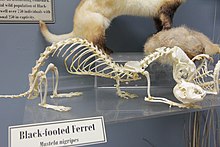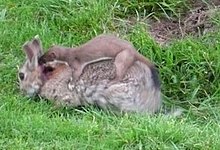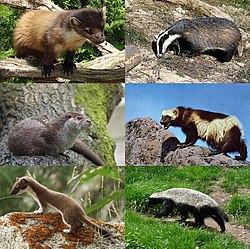What Animal Is The Cousin Of A Weasel
| Mustelidae Temporal range: [one] | |
|---|---|
| | |
| Scientific classification | |
| Kingdom: | Animalia |
| Phylum: | Chordata |
| Grade: | Mammalia |
| Order: | Carnivora |
| Superfamily: | Musteloidea |
| Family unit: | Mustelidae Chiliad. Fischer de Waldheim, 1817 |
| Type genus | |
| Mustela Linnaeus, 1758 | |
| Subfamilies | |
| |
The Mustelidae (;[2] from Latin mustela, weasel) are a family of carnivorous mammals, including weasels, badgers, otters, ferrets, martens, minks and wolverines, among others. Mustelids ([3]) are a diverse group and grade the largest family unit in the order Carnivora, suborder Caniformia. They contain about 66–70 species across nine subfamilies.[4]
Variety [edit]

Mustelids vary profoundly in size and behaviour. The to the lowest degree weasel tin can be under a foot in length, while the giant otter of Amazonian Due south America can measure up to 1.7 yard (5 ft vii in) and ocean otters can exceed 45 kg (99 lb) in weight. Wolverines can crush basic every bit thick as the femur of a moose to go at the marrow, and have been seen attempting to drive bears abroad from their kills. The sea otter uses rocks to break open shellfish to swallow. Martens are largely arboreal, while European badgers dig extensive tunnel networks, called setts. Some mustelids have been domesticated; the ferret and the tayra are kept as pets (although the tayra requires a Dangerous Wild fauna licence in the United kingdom of great britain and northern ireland), or as working animals for hunting or vermin control. Others have been important in the fur trade—the mink is often raised for its fur.
Being one of the virtually species-rich families in the order Carnivora, the family Mustelidae also is 1 of the oldest. Mustelid-similar forms first appeared about forty million years agone (Mya), roughly coinciding with the appearance of rodents. The mutual ancestor of modern mustelids appeared about 18 Mya.[4]
Characteristics [edit]

Within a large range of variation, the mustelids exhibit some common characteristics. They are typically minor animals with elongated bodies, brusk legs, short, round ears, and thick fur.[5] Most mustelids are solitary, nocturnal animals, and are active year-round.[half-dozen]
With the exception of the ocean otter,[7] they have anal scent glands that produce a strong-smelling secretion the animals use for sexual signaling and marking territory.
Almost mustelid reproduction involves embryonic diapause.[8] The embryo does non immediately implant in the uterus, but remains fallow for some fourth dimension. No development takes place as long every bit the embryo remains unattached to the uterine lining. As a result, the normal gestation period is extended, sometimes up to a year. This allows the young to be born nether favorable ecology weather. Reproduction has a large energy cost, so information technology is to a female'southward do good to have available nutrient and mild weather. The young are more likely to survive if birth occurs later on previous offspring take been weaned.
Mustelids are predominantly cannibal, although some eat vegetable affair at times. While not all mustelids share an identical dentition, they all possess teeth adjusted for eating flesh, including the presence of shearing carnassials. One characteristic trait is a meat-shearing upper-back molar that is rotated xc°, towards the within of the rima oris.[nine] [10] With variation between species, the most common dental formula is 3.1.three.1 three.1.3.2 .[vi]
Ecology [edit]

The fisher, tayra, and martens are partially arboreal, while badgers are fossorial. A number of mustelids accept aquatic lifestyles, ranging from semiaquatic minks and river otters to the fully aquatic body of water otter, which is 1 of the few nonprimate mammals known to use tools while foraging. It uses "anvil" stones to crack open the shellfish that grade a significant part of its diet. It is a "keystone species", keeping its prey populations in balance so some practice non outcompete the others and destroy the kelp in which they live.
The black-footed ferret is entirely dependent on another keystone species, the prairie dog. A family of four ferrets eats 250 prairie dogs in a twelvemonth; this requires a stable population of prairie dogs from an expanse of some 500 acres (2.0 km2).
Nomenclature [edit]
Skunks were formerly included as a subfamily of the mustelids, just are now regarded every bit a split family unit (Mephitidae).[11] Mongooses bear a striking resemblance to many mustelids, but belong to a distinctly different suborder—the Feliformia (all those carnivores sharing more than recent origins with the cats) and not the Caniformia (those sharing more recent origins with the dogs). Because mongooses and mustelids occupy similar ecological niches, convergent development has led to similarity in form and behavior.[ citation needed ]
Diversity [edit]
The oldest known mustelid from Northward America is Corumictis wolsani from the early and late Oligocene (early and late Arikareean, Ar1–Ar3) of Oregon.[1] Heart Oligocene Mustelictis from Europe might exist a mustelid, as well.[ane] Other early fossils of the mustelids were dated at the end of the Oligocene to the outset of the Miocene. Which of these forms are Mustelidae ancestors and which should exist considered the kickoff mustelids is unclear.[12]
The fossil tape indicates that mustelids appeared in the tardily Oligocene menstruation (33 Mya) in Eurasia and migrated to every continent except Antarctica and Australia (all the continents that were continued during or since the early Miocene). They reached the Americas via the Bering land span.
Man uses [edit]

Several mustelids, including the mink, the sable (a type of marten), and the stoat (ermine), boast exquisite and valuable furs, and so take been hunted since prehistoric times. From the early Center Ages, the merchandise in furs was of great economic importance for northern and eastern European nations with large native populations of fur-bearing mustelids, and was a major economic impetus behind Russian expansion into Siberia and French and English expansion in N America. In recent centuries, fur farming, notably of mink, has also become widespread and provides the majority of the fur brought to market.
Ane species, the sea mink (Neogale macrodon) of New England and Canada, was driven to extinction by fur trappers. Its appearance and habits are most unknown today because no complete specimens tin can be found and no systematic contemporary studies were conducted.
The sea otter, which has the densest fur of whatsoever animal,[13] narrowly escaped the fate of the sea mink. The discovery of large populations in the North Pacific was the major economic driving strength behind Russian expansion into Kamchatka, the Aleutian Islands, and Alaska, equally well as a cause for conflict with Japan and foreign hunters in the Kuril Islands. Together with widespread hunting in California and British Columbia, the species was brought to the brink of extinction until an international moratorium came into effect in 1911.
Today, some mustelids are threatened for other reasons. Bounding main otters are vulnerable to oil spills and the indirect effects of overfishing; the black-footed ferret, a relative of the European polecat, suffers from the loss of American prairie; and wolverine populations are slowly declining because of habitat devastation and persecution. The rare European mink (Mustela lutreola) is 1 of the most endangered mustelid species.[14]
1 mustelid, the ferret, has been domesticated and is a fairly common pet.
Systematics [edit]
The 68 contempo mustelids (67 extant species) are classified into eight subfamilies in 22 genera:[iv] [15]
Subfamily Taxidiinae
Subfamily Mellivorinae
Subfamily Melinae
Subfamily Helictidinae
Subfamily Guloninae [16]
Subfamily Ictonychinae [16]
| Subfamily Lutrinae (otters)
Subfamily Mustelinae (weasels, ferrets, and mink)
|
Fossil mustelids Extinct genera of the family unit Mustelidae include:
- Brachypsalis
- Chamitataxus
- Corumictis [one]
- Cyrnaonyx
- Ekorus
- Eomellivora
- Hoplictis [18]
- Megalictis
- Oligobunis
- Plesictis
- Sthenictis
- Teruelictis
- Trochictis [19]
Phylogeny [edit]
Multigene phylogenies synthetic by Koepfli et al. (2008)[20] and Constabulary et al. (2018)[4] found that Mustelidae comprises nine subfamilies. The early mustelids appear to have undergone 2 rapid bursts of diversification in Eurasia, with the resulting species spreading to other continents only later.[20]
-

Phylogenetic tree of Mustelidae. Contains 53 of the 79 putative mustelid species.[four]
-

Fourth dimension-calibrated tree of Mustelidae showing divergence times between lineages. Split times include: 28.8 million years (Ma) for mustelids vs. procyonids; 17.viii Ma for Taxidiinae; fifteen.5 Ma for Mellivorinae; fourteen.8 Ma for Melinae; 14.0 Ma for Guloninae + Helictidinae; xi.v Ma for Guloninae + Naquinae vs. Helictidinae; 12.0 Ma for Ictonychinae; 11.six Ma for Lutrinae vs. Mustelinae.[4]
Mustelid species diversity is often attributed to an adaptive radiation coinciding with the mid-Miocene climate transition. Contrary to expectations, Constabulary et al. (2018)[4] establish no evidence for rapid bursts of lineage diversification at the origin of the Mustelidae, and further analyses of lineage diversification rates using molecular and fossil-based methods did not find associations between rates of lineage diversification and mid-Miocene climate transition equally previously hypothesized.
Come across also [edit]
- List of heaviest extant mustelids
References [edit]
- ^ a b c d Paterson, R.; Samuels, J.X.; Rybczynski, Northward.; Ryan, M.J.; Maddin, H.C. (2019). "The earliest mustelid in North America". Zoological Journal of the Linnean Club. 188 (4): 1318–1339. doi:10.1093/zoolinnean/zlz091.
- ^ "Mustelidae". Merriam-Webster Dictionary.
- ^ "mustelid". Dictionary.com Unabridged (Online). n.d.
- ^ a b c d e f g Law, C. J.; Slater, Yard. J.; Mehta, R. S. (2018-01-01). "Lineage Diverseness and Size Disparity in Musteloidea: Testing Patterns of Adaptive Radiation Using Molecular and Fossil-Based Methods". Systematic Biology. 67 (ane): 127–144. doi:10.1093/sysbio/syx047. PMID 28472434.
- ^ Law, C. J.; Slater, G. J.; Mehta, R. S. (2019). "Shared extremes by ectotherms and endotherms: Body elongation in mustelids is associated with pocket-size size and reduced limbs". Evolution. 73 (4): 735–749. doi:10.1111/evo.13702. PMID 30793764.
- ^ a b Male monarch, Carolyn (1984). Macdonald, D. (ed.). The Encyclopedia of Mammals. New York: Facts on File. pp. 108–109. ISBN978-0-87196-871-5.
- ^ Kenyon, Karl Westward. (1969). The Body of water Otter in the Eastern Pacific Ocean. Washington, D.C.: U.S. Agency of Sport Fisheries and Wildlife.
- ^ Amstislavsky, Sergei, and Yulia Ternovskaya. "Reproduction in mustelids." Beast Reproduction Science sixty (2000): 571-581.
- ^ Pratt, Philip. "Dentition of the Wolverine". The Wolverine Foundation, Inc. Archived from the original on 27 May 2008. Retrieved one July 2007.
- ^ Taylor, Ken (1994). "Wolverine". Wild fauna Notebook Series. Alaska Department of Fish & Game. Archived from the original on 6 Dec 2006. Retrieved 21 January 2007.
- ^ Dragoo and Honeycutt; Honeycutt, Rodney L (1997). "Systematics of Mustelid-like Carnivores". Journal of Mammalogy. 78 (2): 426–443. doi:10.2307/1382896. JSTOR 1382896.
- ^ Wund, M. (2005). "Mustelidae". Fauna Diversity Web. University of Michigan. Retrieved 2020-08-xiv .
- ^ Perrin, William F., Wursig, Bernd, and Thewissen, J.G.Yard. Encyclopedia of Marine Mammals, 2nd ed. Academic Press; 2 edition (December 8, 2008). Page 529. [1]
- ^ Lodé, Thierry; Cornier, J. P.; Le Jacques, D. (2001). "Decline in endangered species as an indication of anthropic pressures: the case of European mink Mustela lutreola western population". Ecology Direction. 28 (6): 727–735. Bibcode:2001EnMan..28..727L. doi:10.1007/s002670010257. PMID 11915962. S2CID 27062634.
- ^ "Explore the Database". www.mammaldiversity.org . Retrieved 2021-06-25 .
- ^ a b Nascimento, F. O. do (2014). "On the right name for some subfamilies of Mustelidae (Mammalia, Carnivora)". Papéis Avulsos de Zoologia (São Paulo). 54 (21): 307–313. doi:x.1590/0031-1049.2014.54.21.
- ^ Patterson, Bruce D.; Ramírez-Chaves, Héctor E.; Vilela, Júlio F.; Soares, André E. R.; Grewe, Felix (2021). "On the nomenclature of the American clade of weasels (Carnivora: Mustelidae)". Periodical of Animal Variety. iii (2). doi:10.29252/JAD.2021.3.2.1 (inactive 28 February 2022). ISSN 2676-685X.
{{cite journal}}: CS1 maint: DOI inactive as of February 2022 (link) - ^ Valenciano, A.; Jiangzuo, Q.; et al. (March 2019). "First Record of Hoplictis (Carnivora, Mustelidae) in Eastern asia from the Miocene of the Ulungur River Area, Xinjiang, Northwest Mainland china". Acta Geologica Sinica. 93 (2): 251–264. doi:ten.1111/1755-6724.13820. S2CID 133900941.
- ^ Morlo, M.; LeMaitre, A.; et al. (November 2019). "First tape of the mustelid Trochictis (Carnivora, Mammalia) from the early on Late Miocene (MN nine/x) of Germany and a re-appraisal of the genus Trochictis". Historical Biology. 33 (eight): 1183–1195. doi:10.1080/08912963.2019.1683172. S2CID 209607263.
- ^ a b Koepfli, Klaus-Peter; Deere, Grand.A.; Slater, M.J.; Begg, C.; Begg, K.; Grassman, 50.; Lucherini, Chiliad.; Veron, G.; Wayne, R.K. (Feb 2008). "Multigene phylogeny of the Mustelidae: Resolving relationships, tempo and biogeographic history of a mammalian adaptive radiation". BMC Biological science. 6: 10. doi:10.1186/1741-7007-vi-10. PMC2276185. PMID 18275614.
Further reading [edit]
- Whitaker, John O. (1980-ten-12). The Audubon Lodge Field Guide to North American Mammals . Alfred A. Knopf. p. 745. ISBN978-0-394-50762-0.
External links [edit]
| | Wikimedia Commons has media related to Mustelidae. |
- "The Mighty Weasel" February 19, 2020 Nature
Source: https://en.wikipedia.org/wiki/Mustelidae
Posted by: troupeheith1981.blogspot.com


0 Response to "What Animal Is The Cousin Of A Weasel"
Post a Comment